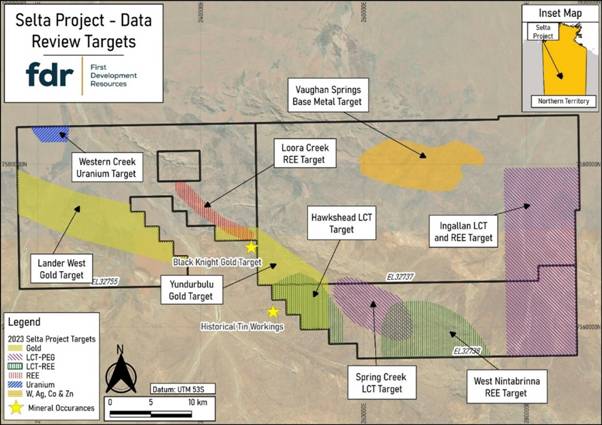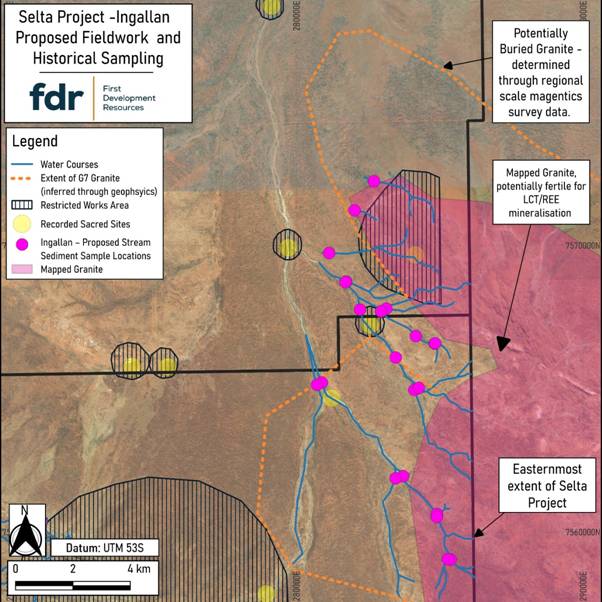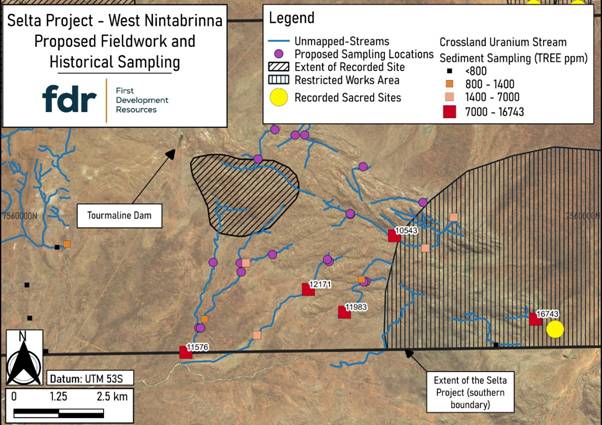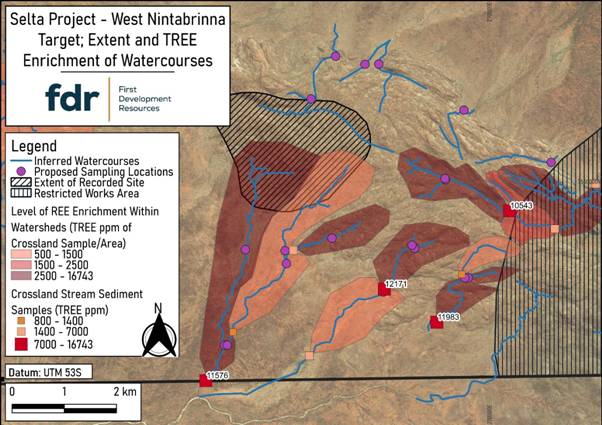19 November 2025
First Development Resources plc
('First Development", "FDR" or the "Company')
Selta Project - Rare-Earth Element exploration update
First Development Resources plc (AIM: FDR) the UK based, Australia focused exploration company with mineral interests in Western Australia and the Northern Territory, is pleased to provide an update in respect of the rare-earth element ("REE") exploration strategy at its Selta Project ("Selta" or the "Project") located in the Aileron Province of Australia's Northern Territory.
HIGHLIGHTS
· First-pass rare-earth element exploration at the Selta Project will begin in early December 2025, focusing on stream-sediment sampling and reconnaissance mapping.
· Two priority REE target areas-Ingallan and West Nintabrinna-have been defined following detailed desktop studies, with both areas showing elevated historical Total REE results.
· The planned field programme aims to validate historical geochemical anomalies and generate new targets for potential follow-up mapping, sampling, and investigation of ionic clay potential at Ingallan.
Tristan Pottas, Chief Executive Officer of FDR, commented:
"Last month we stated our intention to fast-track REE exploration at Selta. The decision to accelerate this work was in response to a shift in geo-political policy to secure the supply and processing of Critical Minerals and REEs. I am pleased to report that a team will be on the ground at Selta in early December to conduct this important first phase of targeted REE exploration.
Exploration will include stream sediment sampling and reconnaissance mapping. The primary objective of which is to advance our understanding of elevated surface geochemical responses associated with the underlying lithological and structural features, and to identify potential zones of mineralisation for follow-up exploration."
SELTA RARE EARTH TARGETS
Following the completion of multiple phases of in-depth desktop review, two REE target areas have been defined at Selta. The target areas are named Ingallan and West Nintabrinna, their locations, alongside other target areas on the Selta Project, are shown in Figure 1.

Notes: LCT-PEG = lithium, caesium, and tantalum (LCT) pegmatite (PEG)
Figure 1: Selta Project Data Review Targets
PLANNED FIELD EXPLORATION PROGRAMME - DECEMBER 2025
The field exploration programme which is expected to last one week is intended to validate and replicate, on an increased density, historical geochemical data which indicated elevated total rare-earth elements ("TREE") associated with the underlying geology across the Ingallan and West Nintabrinna target areas. Samples collected on this fieldwork will be processed and analysed in January 2026; the results will inform future exploration on the property. Such exploration may include detailed mapping and sampling on both Ingallan and West Nintabrinna. On the latter, the Company is also planning test auger sampling to determine the area's Ionic Clay potential.
INGALLAN STREAM SEDIMENT SAMPLING
The Ingallan area has received minimal exploration and is mapped as a gneissic granite. The target is largely based on and around this mapped intrusive body in the east of the property. This granite is noted to have mineral occurrences of tin (Sn) and beryllium (Be) approximately 6km to the east of the Selta licence area. Stream sediment sampling completed in 2011 by former ASX listed company Crossland Uranium1 ("Crossland") identified two elevated TREE samples from watercourses that drained from the granite, suggesting a local enrichment. The granite is not known to have been drilled, or sampled in any way to date, and is inferred to extend to the northeast below a cover of surficial geology / weathered granite.
Stream sediments are a highly powerful tool for regional scale "first pass" exploration and are especially powerful when looking for heavier minerals such as those which contain REEs, as the action of water concentrates heavier metals. This type of sampling is not as effective for lighter minerals and elements - such as lithium (Li) hosted minerals (spodumene, petalite and lepidolite) or the clays that might host REE in their structure. As such, stream sediment sampling on Ingallan can only be reliably used to evaluate primary (pegmatite) REE mineralisation.
Twenty-two proposed sampling locations are shown in Figure 2. Sampling at Ingallan is designed to target primary and second / third-order streams to give an overview of the REE potential of the granite itself. The main point of reference for this sampling is the historical sampling completed by Crossland, supplemented by the mapped geology.

Figure 2: Selta Project - Ingallan Proposed Fieldwork December 2025
WEST NINTABRINNA STREAM SEDIMENT SAMPLING
The principal data source in this area is the historical geochemical sampling completed by Crossland which shows highly elevated TREE results from multiple watersheds in the target area. The underlying granite is understood to be fertile due to multiple known mineral occurrences of tungsten (W) to the south and historical tin workings and mineral occurrences to the west (both off the Selta licence area). The granite itself is shown to have a high uranium (U) / thorium (Th) ratio. A high U / Th ratio in granites and other intrusive rocks can indicate fractionated, evolved magmatic fluids, which are often enriched in incompatible elements such as REE, Li, and tantalum (Ta), these elements are often found in pegmatites associated with the granite, or enriched in the granite itself.
Based on the current level of understanding at West Nintabrinna, this area is considered prospective for primary (pegmatite) REE mineralisation. As with Ingallan, there are restrictions on the working area due to the Extent of a Recorded Site (in the west), and a Restricted Works area (in the east). The twenty-three sampling locations (Figure 3) have been selected to evaluate the REE potential of areas upstream of the sampling points that are outside either of the restricted areas and include locations near the historical sampling completed by Crossland.

Figure 3: Selta Project - West Nintabrinna Proposed Fieldwork December 2025
Stream sediment sampling is a significant tool in geochemical exploration. The composition of stream sediments reflects the bedrock geology, overburden cover and metalliferous mineralisation. Stream sediment sampling programmes are an effective way to "screen" exploration areas and home in on catchment areas which chemical analysis suggests are prospective. Drainage channels originate from discrete catchment areas; therefore, any samples of significance found in a channel will have originated from a specific catchment, enabling follow up exploration to focus on specific areas (Figure 4).

Figure 4: Selta Project - West Nintabrinna Target; Historical TREE Catchment Areas and Proposed Sampling Locations
REE exploration is central to the Company's plans at Selta. The December 2025 stream sediment programme is the first phase of systematic, methodical exploration which has been designed to better understand the REE potential across the Project area. FDR is hoping to capitalise on the increased profile of REE and potentially benefit from the recently announced United States - Australia Critical Minerals Framework and its aim of accelerating the development of mining, processing and recycling projects in priority commodities which it is anticipated will include Junior explorers. The new Framework includes a USD$1 billion investment from both nations over the next six months to help accelerate and unlock an USD$8.5 billion pipeline of critical mineral projects, with a joint commitment to fast-track approvals, which could significantly impact the junior exploration sector.2
REFERENCES
1. Melville, P. (2015) Fourth Annual and Final Report for EL 28492 for the period 28 July 2011 to 22 May 2015. Crossland Strategic Metals Ltd, Mount Stafford, Northern Territory. Submitted to the Northern Territory Department of Mines and Energy.
2. Minerals Council of Australia (2025) US-Australia Framework to unlock USD$8.5 Billion Critical Minerals Pipeline [online] (October 21 2025). Available at: https://minerals.org.au/resources/us-australia-framework-to-unlock-usd8-5-billion-critical-minerals-pipeline
QUALIFIED PERSON STATEMENT
The technical information contained in this disclosure has been reviewed and approved by Mr Nicholas O'Reilly (MSc, DIC, MIMMM QMR, MAusIMM, FGS), who is a qualified geologist and acts as the Qualified Person under the AIM Rules - Note for Mining and Oil & Gas Companies. Mr O'Reilly is a principal consultant working for Mining Analyst Consulting Ltd which has been retained by First Development Resources plc to provide technical support.
GLOSSARY
| Term |
Definition |
| Aileron Province |
A large geological region in the Northern Territory made up of ancient granites and metamorphic rocks, known for hosting minerals such as rare earths, uranium and lithium. |
| Augering |
A shallow drilling method that uses a spiral drill to collect soil or weathered rock samples from just below the surface. |
| Catchment Area |
The area of land that drains water into a particular stream; minerals in a sample likely come from this upstream area. |
| Critical Minerals |
Minerals essential for modern technologies that have a high risk of supply shortages, including REE, lithium and tantalum. |
| Fractionation (Magmatic) |
A process during cooling of magma where certain elements become concentrated in the final melt, enriching rocks in REE, lithium, tin and tantalum. |
| Gneissic Granite |
A granite that has been deformed by heat and pressure, giving it a banded appearance. |
| Ionic Clay |
Clay-rich material where rare-earth elements are loosely attached to clay surfaces and can be extracted using mild leaching. |
| LCT Pegmatite |
A coarse-grained igneous rock enriched in lithium, caesium and tantalum, often hosting lithium minerals. |
| Mineralisation |
The natural concentration of minerals in rocks or sediments to levels that may have economic value. |
| Pegmatite |
A very coarse-grained igneous rock formed from late-stage magma, often containing rare metals and REE. |
| Primary Mineralisation |
Mineral deposits found in the original bedrock where they formed. |
| REE (Rare-Earth Elements) |
A group of 17 metallic elements used in magnets, electronics and renewable energy technologies. |
| Recorded Sacred Site |
A recorded sacred site is a site that is known to the Authority but has not been registered and includes recorded sacred burial sites. The Authority may hold the information required to register the site should this become the wishes of the custodians. Alternatively, a recorded sacred site may still require further research in order to obtain all necessary information. |
| Restricted Works Area |
Areas where exploration is limited or prohibited due to cultural or environmental regulations. |
| Stream Sediment Sampling |
A method where sediment from streams is analysed to identify upstream sources of mineralisation. |
| Surficial Geology |
Loose soils and weathered materials covering solid rock. |
For further information visit www.firstdevelopmentresources.com or contact the following:
| First Development Resources plc Tristan Pottas (CEO) |
Tel: +44 (0) 20 3778 1397 |
| Beaumont Cornish Limited Nominated Adviser Roland Cornish / Asia Szusciak |
Tel: +44 (0) 20 7628 3396 |
| SI Capital Limited Broker Nick Emerson |
Tel: +44 (0) 1483 413 500 |
Beaumont Cornish Limited ("Beaumont Cornish") is the Company's Nominated Adviser and is authorised and regulated by the FCA. Beaumont Cornish's responsibilities as the Company's Nominated Adviser, including a responsibility to advise and guide the Company on its responsibilities under the AIM Rules for Companies and AIM Rules for Nominated Advisers, are owed solely to the London Stock Exchange. Beaumont Cornish is not acting for and will not be responsible to any other persons for providing protections afforded to customers of Beaumont Cornish nor for advising them in relation to the proposed arrangements described in this announcement or any matter referred to in it.
ABOUT FIRST DEVELOPMENT RESOURCES
First Development Resources' assets comprise eight granted tenements covering a total area of 2,314.4km2. Five of the tenements, comprising three prospective copper-gold projects, are located in Western Australia (WA) while the remaining three tenements, comprising a rare-earth element (REE), uranium, lithium and gold project, are located in the Australian's Northern Territory. All tenements are wholly owned by FDR. The assets are a mixture of drill ready and earlier stage exploration.
The WA Projects include the Company's Wallal Project as well as Ripon Hills and Braeside West Projects situated in the Paterson Province, which is widely regarded as one of the most productive regions in Australia for the discovery of world-class gold-copper deposits, and which is home to several world-class mines and more recent discoveries.
The Selta Project in the Northern Territory is located in an area considered highly prospective for uranium and rare-earth element mineralisation along with base and precious metal mineralisation. Numerous companies are actively exploring within the region.
Beyond the existing portfolio, FDR is actively looking to expand its portfolio through the acquisition of early-stage exploration projects in Australia.